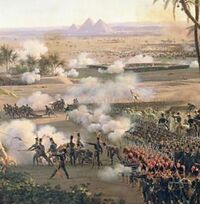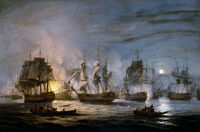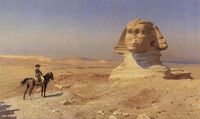
The Battle of the Pyramids, fought between the French and the Mamluks.
The French campaign in Egypt and Syria was an expedition to the Orient by the French Armée d'Orient, under the command of Napoleon, from 1798 to 1801. The campaign started with a few early victories, including the Battle of the Pyramids, but Admiral Nelson's naval victory at the Nile prevented any substantial gain. A brief excursion into neighboring Syria was also successful at first, but after the French return, Napoleon was forced to leave his army and return to France, where he would launch a coup d'etat and become First Consul of the French Republic.
History[]
Prelude[]
In December 1797, Napoleon returned to Paris from his victories at the command of the Army of Italy. The enthusiasm of the Parisians was immense, and the festivals in his honor innumerable. About this time the Directory seems to have had the intention of invading England, and had brought an army together for that purpose. The command was conferred on Napoleon, who at first professed to favor the design, but who well knew its impracticability. It has been thought by many that this proposal was merely a feint to cover the real design of the Directory, namely, the invasion of Egypt, as a preliminary step to the conquest of British India.[1]
Departure and campaign[]

The Battle of the Nile
An army of 36,000 men was collected and embarked at Toulon in a fleet commanded by François-Paul Brueys d'Aigalliers. A body of scientific and artistic explorers accompanied it. Later, the French landed at Malta on 9 June 1798, and the next day took possession of the island, in which they left a garrison. Ten days after the fleet resumed its voyage, they reached Alexandria. With that city being taken, Napoleon and the army advanced on Cairo. Here they encountered a large body of Mamluks, which, after a long and bloody struggle, known as the battle of the Pyramids, they repulsed. Many of the surrounding tribes thereupon submitted to the French, who thus for a while held a possession of the whole of Egypt. Thinking himself secure in his conquest, Napoleon immediately set about reorganizing the civil and military government of the country; but fortune was preparing for him a terrible reverse. The English admiral Horatio Nelson, who had long been in pursuit of his fleet, found it moored in the Bay of Aboukir, and, with the exception of four vessels which contrived to escape, utterly destroyed it.[1]

Napoleon before the Sphinx.
All means of return to Europe for the French were thus cut off, and to add to their misfortunes, the sultan declared war against them, and a short time after serious disturbances broke out in Cairo, which were only suppressed by horrible massacres. Napoleon resolved to meet the Turkish forces assembling in Syria. In February 1799 he crossed the desert with about 13,000 men; took Arish and Gaza, and stormed Jaffa, where a great number of Turkish prisoners were deliberately massacred. He attacked Acre, which was defended by a Turkish garrison under Jezzar Pasha, assisted by Sir William Sidney Smith and a small body of English sailors and marines. After 60 days of numerous failed attempts, he gave up the siege and returned to Egypt, leaving the whole country on fire behind him. He reentered Cairo on 14 June, having lost about 4,000 men in the Syrian expedition. About the middle of July the sultan landed a force of 18,000 at Abukir, which Napoleon attacked and almost annihilated. His position was far from agreeable, however; he had signally failed in the great objects of his expedition, and besides news had reached him of disaster to the French arms in Italy and of confusion in Paris. On 22 August he embarked in a frigate, and, on 9 October, landed at Fréjus, having narrowly escaped capture several times by British cruisers.[1]
Effects on Egyptology[]
One of the main historiographic effects of Napoleon's famous Oriental expedition is his study of Egypt. While mainly a military expedition, Napoleon took with him many artists and historians, and were able to recover and study artefacts such as the Rosetta Stone, which provided three inscriptions, one of them Egyptian hieroglyphics, that provided a key to understanding the hitherto incomprehensible ancient language.
The Rosetta Stone was found by the French near the mouth of the Rosetta branch of the Nile. By the sixteenth article of the Capitulation of Alexandria, all the objects collected by the French Institute of Egypt and by others were to be delivered up to the British. After some discussion, Lord Hutchinson, the British commander, gave up the claim to all objects of natural history, but insisted on the complete fulfilment of the sixteenth article as to all other things. The Rosetta stone was among the antiquities thus claimed, and it was conveyed from the house of the French commander General Menou, whose private property it had become, by General Turner, at the command of Lord Hutchinson. It was placed on board the frigate Egyptienne, which had been taken in the harbour of Alexandria, and arrived at Portsmouth in February, 1802. General Turner came to England in the same vessel.[2]
The discovery of this triple inscription excited a very lively interest among all who had devoted themselves to Egyptian archaeology, since it gave hopes that we should at last be able by means of it to decipher the numerous inscriptions of ancient Egypt. The Rosetta Stone contains parts of three distinct inscriptions; the highest on the stone is in what we generally call hieroglyphics; the second is in that character commonly called the "enchorial," or " the characters of the country;" and the third, which is in Greek, declares at the end that the decree which this stone contains was cut in three different characters, the "sacred characters," "those of the country" or the "enchorial," and "the Greek."[2]